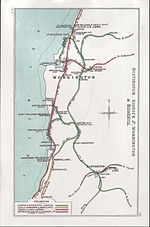Distington
Borough of CopelandCivil parishes in CumbriaCumbria geography stubsUse British English from September 2019Villages in Cumbria

Distington () is a large village and civil parish in Cumbria, England, 3 miles (4.8 km) south of Workington and 4 miles (6.4 km) north of Whitehaven. Historically a part of Cumberland, the civil parish includes the nearby settlements of Common End, Gilgarran and Pica. The parish had a population of 2,247 in the 2001 census, increasing slightly to 2,256 at the 2011 census.South of the village by the Lowca Beck are the fragmentary remains of Hayes Castle, a manor house fortified by Robert de Leyburn in 1322.
Excerpt from the Wikipedia article Distington (License: CC BY-SA 3.0, Authors, Images).Distington
KIlnside Place,
Geographical coordinates (GPS) Address Nearby Places Show on map
Geographical coordinates (GPS)
| Latitude | Longitude |
|---|---|
| N 54.6 ° | E -3.54 ° |
Address
KIlnside Place
KIlnside Place
CA14 5TG , Distington
England, United Kingdom
Open on Google Maps








